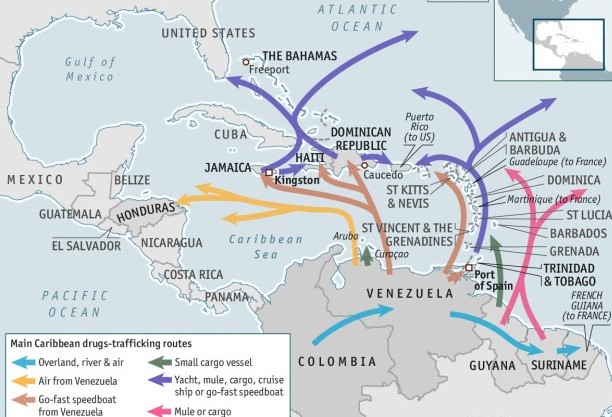By
Ricardo Swire
Navigating the Caribbean Sea section of the Atlantic Ocean is a specialist skill. On the night of March 3, 2017 a St Vincent & the Grenadines flagged, 145 feet, inter-island schooner sank in Grenada’s territorial waters eight miles offshore.
Recovered charts plotted Motor Vessel Persia’s initial port of call as Grenada. Not long after the Island Wide Shipping registered cargo ship’s Nicaraguan Captain and nine crew set sail for Trinidad & Tobago, MV Persia sprung a disastrous leak, encountered in rough seas and powerful winds.
Grenada’s Coast Guard responded to Save Our Souls (SOS) distress transmissions, received by the SVG Coast Guard Base on Canouan Island. MV Persia’s crew were saved but the ship sunk. Transnational criminal organizations use this waterway as a main trafficking passage. The Caribbean Sea is bordered westward by Mexico. On its south-west demarcation sits Central America, the Greater Antilles northward.
During the 1980s and 1990s most drugs smuggled to mainland America departed from the Caribbean and South Florida. Mexico became the US primary Methamphetamine supplier. Today 95 percent of US destined cocaine shipments also originate from Mexico. Modern patterns show transnational drug cartels employ the most adroit mariners to control Caribbean Sea routes.
Three years ago a SVG Coast Guard, Police Rapid Response Unit and Special Services Unit joint operation intercepted 34 kilos of cocaine in the mini archipelago’s territorial waters. The early morning SVG Drug Squad led intelligence driven mission, tracked a local speedboat as it collected the cocaine consignment. The multi-million dollar drug package and a Venezuelan trafficker were transported to Questelles beach, on SVG’s southwest coast. The law enforcement team found one nylon bag containing 34 brick shaped cocaine blocks, each one kilo in weight.
South American cocaine flows have surged towards CARICOM islands. Intelligence reports named St Kitts & Nevis and St Martin as “air drop-off points” for Latin American cocaine. The US spearheaded Caribbean Corridor Strike Force and Drug Enforcement Administration’s (DEA) Caribbean Division have both adjusted tactically. On February 16, 2017 a United States Coast Guard (USCG) cutter, patrolling the Caribbean Sea, stopped and boarded “Lady Michelle” a Vincentian owned and flagged fishing boat. Lady Michelle’s four-man Guyanese crew were journeying on a monitored drug trafficking route.
The Vincentian fishing vessel also operated in “dark waters” considered too deep for fishing. The USCG’s boarding party discovered 4.2 tons, or 9,259 pounds of cocaine, valued at US$125 million, aboard Lady Michelle. Generally the DEA’s counter-narcotics tactics in the Caribbean Sea mainly focus on America owned territories Puerto Rico and US Virgin Islands. Patterns suggest techno savvy transnational trafficking syndicates recognize that domestic commercial cargo, transported between such territories, is not routinely inspected by US Customs.



No Comments Yet!
You can be first to comment this post!